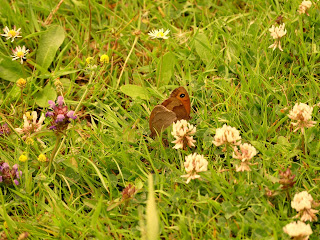 |
| Aphid on dandelion flower. |
 |
| Oedemera nobilis, Thick-legged flower beetle |
Self-sown poppies were enjoyed by an undefined bumblebee.
This looks like a Harlequin ladybird on runner beans.
Ladybirds and their larvae are predators of black fly, which are plentiful on my beans. |
| Black flies |
This solitary bee is smothered in pollen and looks as though it has done a good job pollinating the bean flowers.
Yellow Rattle is going to seed now. It is an annual and moves around the garden with the seed dispersal.
The wildflower lawn is attractive to many insects. Here a Red-tailed Bumblebee male possibly as it is not collecting pollen. Or might it be a cuckoo bee?
Above a Red-tailed Bumblebee worker with pollen baskets feeding on clover in the lawn.
With dark wings and short hairs on its legs this might be a Field Cuckoo Bee, Bombus campestris.
A harlequin ladybird larva on a bramble leaf.
Mating Meadow Brown butterflies.
 |
| Female Meadow Brown |






















No comments:
Post a Comment